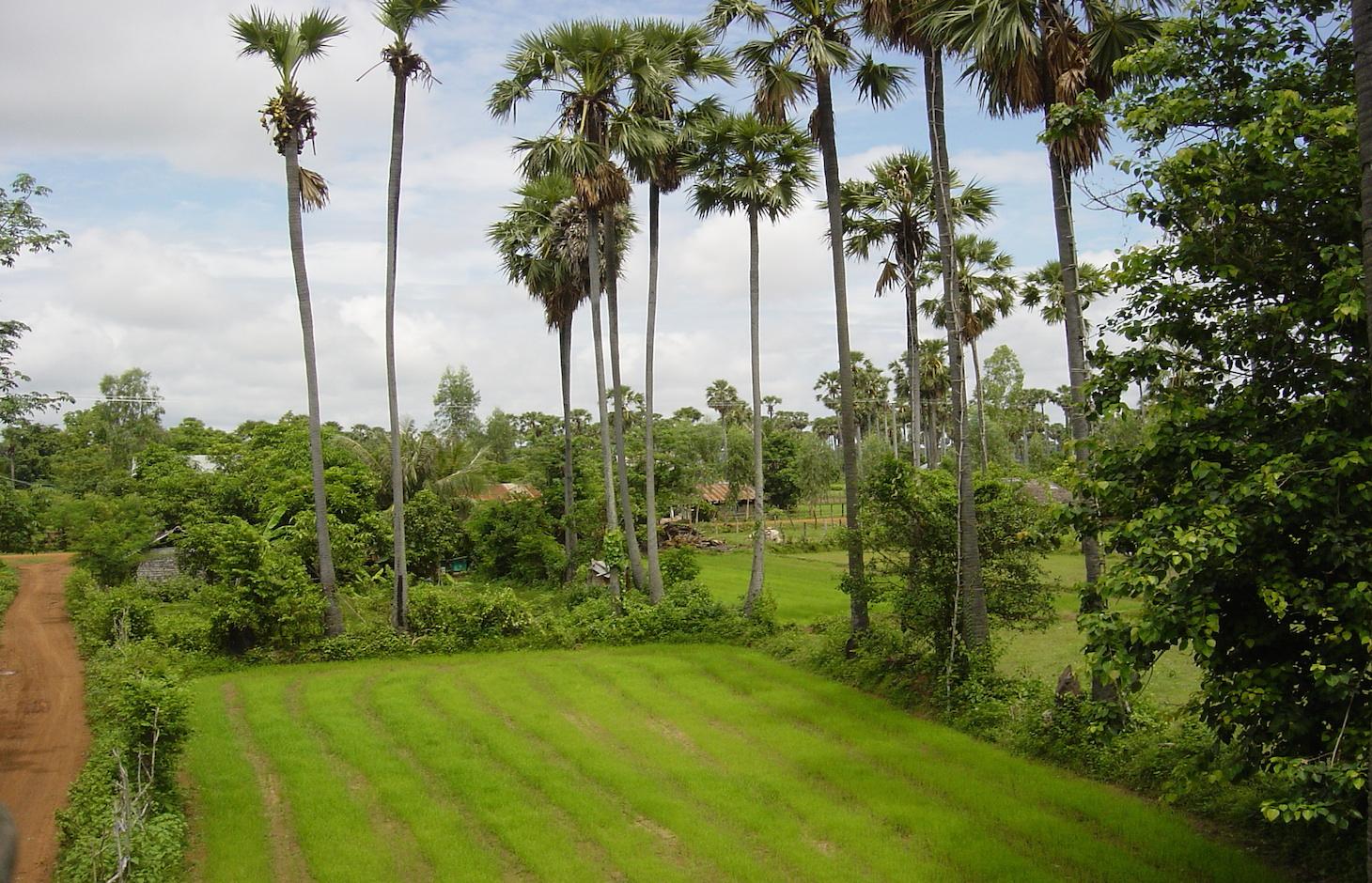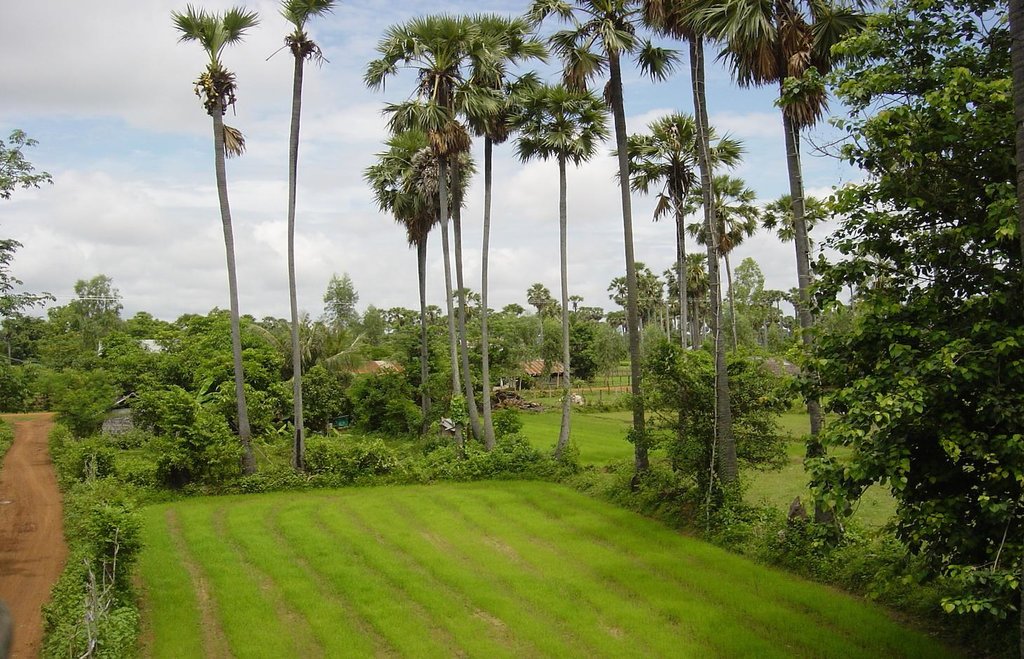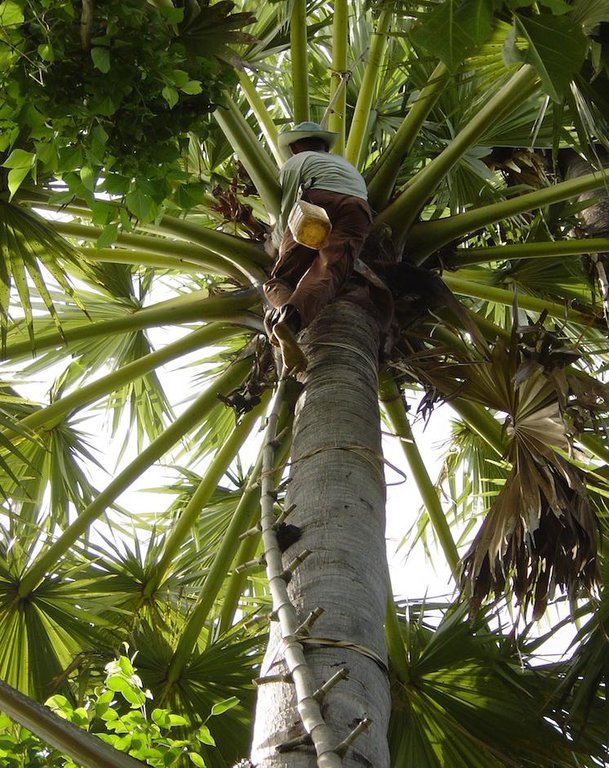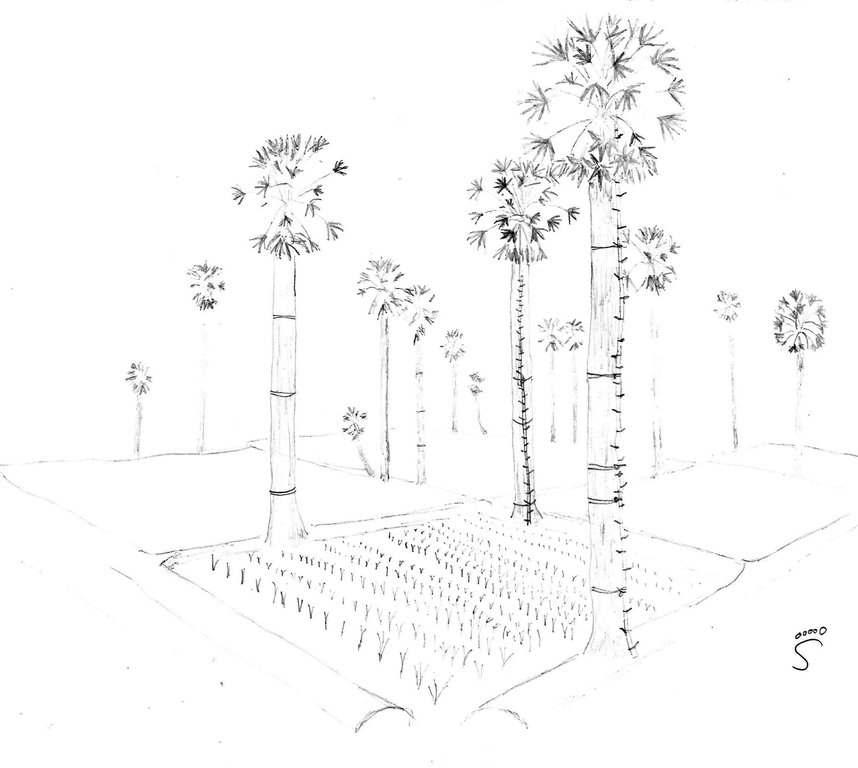Multipurpose use of sugar palm grown on rice field dykes. [كمبوديا]
- تاريخ الإنشاء:
- تحديث:
- جامع المعلومات: Stefan Graf
- المحرر: –
- المُراجع: Deborah Niggli
ការប្រើប្រាស់ដើមតោ្នតដែលដំានៅតាមភ្លឺស្រែ (Khmer)
technologies_1629 - كمبوديا
عرض الأقسام
توسيع الكل طي الكل1. معلومات عامة
1.2 تفاصيل الاتصال بالأشخاص الرئيسيين لمصدر المعلومات والمؤسسات المشاركة في تقييم وتوثيق التقنية
متخصص في الإدارة المستدامة للأراضي:
Khun Lean Hak
kleanghak@yahoo.com / sofdec@camintel.com
SOFDEC/LAREC, www.sofdec.com
1.3 الشروط المتعلقة باستخدام البيانات الموثقة من خلال WOCAT
متى تم تجميع البيانات (ميدانيا)؟:
10/07/2014
يوافق جامع المعلومات والشخص (لاشخاص) الرئيسي لمصدر المعلومات على الشروط المتعلقة باستخدام البيانات الموثقة من خلال WOCAT:
نعم
1.4 إعلان بشأن استدامة التقنية الموصوفة
هل التقنية الموصوفة هنا تمثل مشكلة فيما يتعلق بتدهور الأراضي، بحيث لا يمكن إعلانها تقنية مستدامة لإدارة الأراضي؟:
كلا
2. وصف تقنيةالإدارة المستدامي للأراضي
2.1 وصف مختصر للتقنية
تعريف التقنية:
Sugar palms growing on the dykes along the rice fields are used as source of income and have different effects on the growing of the rice, like reducing the wind speed and thus the evaporation and wind erosion.
2.2 وصف تفصيلي للتقنية
الوصف:
The sugar palm (Borassus flabellifer ) is the national tree of Cambodia, it is well adapted to the local natural environment and there is a long tradition to grow sugar palms. Therefore, only a negligible workload is required for both the establishment (fruits falling down from the already existing trees will grow) and the maintenance of the trees. As the sugar palm is resistant to waterlogging and floods (even in flooded areas in the floodplains), and it grows well at low pH, it is planted/grown on the rice field dykes and around the houses. The trees which are growing around the paddy fields have some positive effects on both soil and rice, as they slow down the wind and thus reduce evaporation and wind erosion. They also attract wildlife, and thus allow the establishment of other vegetation. The trees also have a purifying effect on the groundwater, and cycle the nutrients which are otherwise lost in the groundwater. The sugar palms and their products can be used in manifold ways: the leaves for wickerwork and roofs; the stems as fences, for ropes and strings; the fruits as food, fodder and to make straw palatable for cattle; the sap as fodder, to make wine, sugar, and vinegar; and the trunk as construction wood – these are only some of its uses. They reduce the risk of a complete crop failure, as their products are not subject to weather fluctuations.
After the collectivization of land during the civil war (1975-1979), the land and the trees were newly distributed to the people according to the size of the household. The ownership of the land and of the trees was not related. Until today, the trees can be growing on someone’s land, but can be sold or rented to somebody else who harvests its products.
The main reason to plant sugar palms in this area is the sap collection. In order to collect the sap, firstly bamboo ladders are tied to the sugar palm trees. In the dry season, the tapper climbs up the trees to collect the sap. The male or female inflorescence is crushed with a special tool and a piece of it sliced off. Bottles are hanged beneath the cut part, and the sap will flow into these bottles. The crushing and slicing is repeated twice a day, so the amount of collected sap can be optimized. Most of the sap is cooked on a fire and made into syrup, and if there is too much sap, it is fermented and sold as palm wine.
The fruits that fall down on the rice fields are thrown on the dykes, where they grow. The seedlings tolerate some cattle grazing, as long as only the leaves and not the bud are eaten.
The analysed area is flat (slope < 2%), with a tropical climate (dry season from November to May and wet season from June to October), and the soils are mostly sandy or loamy. The soil has a low fertility, contains little organic matter, and acidifies. The area has been deforested a long time ago, and the groundwater table is rather high (1-2 m during the dry season, on the surface during wet season). Due to climate change, farmers notice more erratic rainfalls, temperature rises and more recurrent droughts. Rice is the predominant crop grown in the area, since it serves as staple food (mix subsistence and commercial activities).
The increasing migration rate (the young generation leaves the villages to work in the cities, garment industry or abroad) results in a decrease of available labour force in the area which has detrimental effects on the agricultural activities. Furthermore, the civil war in the 1970s (Khmer Rouge) led to the loss of agricultural knowledge which different NGOs try to re-establish.
2.3 صور التقنية
2.5 البلد/المنطقة/المواقع التي تم تنفيذ التقنية فيها والتي يغطيها هذا التقييم
البلد:
كمبوديا
المنطقة/الولاية/المحافظة:
Kampong Chhnang
مزيد من التفاصيل حول الموقع:
Rolear Bier / Thnorng Kombot
2.6 تاريخ التنفيذ
في حالة عدم معرفة السنة بالتحديد، يرجى الإشارة إلى التاريخ التقريبي:
- منذ أكثر من 50 عامًا (تقليدي)
2.7 إدخال التقنية
حدد كيف تم إدخال التقنية:
- كجزء من النظام التقليدي (> 50 عامًا)
التعليقات (نوع المشروع، الخ):
It is a traditional tree in Cambodia, with historical use. Its introduction on the rice field dykes is unknown.
3. تصنيف تقنية الإدارة المستدامي للأراضي
3.1 الغرض الرئيسي ( الأغراض الرئيسية) للتقنية
- تحسين الإنتاج
- الحد من تدهور الأراضي ومنعه وعكسه
3.2 نوع (أنواع) استخدام الأراضي الحالية حيث يتم تطبيق التقنية

الأراضي الزراعية
- زراعة سنوية
- زراعة الأشجار والشجيرات
التعليقات:
Major land use problems (compiler’s opinion): Lack of organic matter, lack of water retention in soil, irregularity of rainfall, low soil fertility (sandy soil), monocultures, bare soil during dry season, ploughing, wind erosion and dust storms.
Major land use problems (land users’ perception): Soil fertility is low, rainfall is not secured in the beginning of the rainy season.
3.3 مزيد من المعلومات حول استخدام الأراضي
إمدادات المياه للأرض التي يتم تنفيذ التقنية عليها:
- بعلية
عدد مواسم الزراعة في السنة:
- 1
حدد:
Longest growing period in days: 210, Longest growing period from month to month: June-December
3.4 مجموعةالإدارة المستدامة للأراضي التي تنتمي إليها هذه التقنية
- الحراجة الزراعية
- مصد الريح/حزام حماية
3.5 انتشار التقنية
حدد انتشار التقنية:
- منتشرة بالتساوي على مساحة
إذا كانت التقنية منتشرة بالتساوي على منطقة ما، فحدد المنطقة التقريبية المغطاة:
- 100-10 كم2
التعليقات:
This technology is applied in most parts of Cambodia. Almost everywhere there are some sugar palms growing along the rice fields, but not in this density. The area mentioned is the area in the district where the technology is applied.
3.6 التدابير التقنية في مجال إلادارة المستدامة للأراضي

التدابير النباتية
- V1: غطاء من الأشجار والشجيرات
التعليقات:
Type of vegetative measures: aligned: -along boundary
3.7 الأنواع الرئيسية من تدهور الأراضي التي تناولتها التقنية

تآكل التربة الناتج عن الرياح
- (Et): فقدان التربة السطحية

التدهور الكيميائي للتربة
- (Cn): تراجع الخصوبة وانخفاض محتوى المادة العضوية (غير ناتج عن الانجراف)

التدهور البيولوجي
- (Bh): فقدان الموائل
- (Bs): انخفاض جودة وتركيبة الأنواع/التنوع
التعليقات:
Main causes of degradation: soil management (Ploughing of the soil. Depending on the rainfall, sometimes the land is left bare for several days or weeks.), crop management (annual, perennial, tree/shrub) (Mainly rice is grown in monocultures.), over-exploitation of vegetation for domestic use (Straw is usually removed from the fields.), labour availability (Labour availability is low due to high migration rates (garment industry, drift to the cities, working abroad).)
Secondary causes of degradation: change in temperature (More hot days, the soil dries out faster.), droughts, education, access to knowledge and support services (Little knowledge about soil conservation.), war and conflicts (During the Khmer Rouge regime, a lot of agricultural knowledge got lost.)
3.8 منع أو حد أو عكس تدهور الأراضي
تحديد هدف التقنية فيما يتعلق بتدهور الأراضي:
- منع تدهور الأراضي
4. المواصفات الفنية، وأنشطة التنفيذ، والمدخلات، والتكاليف
4.1 الرسم الفني للتقنية
4.2 المواصفات الفنية/شروحات الرسم الفني
Sugar palms (Borassus flabellifer) with bamboo ladders growing on the dikes around the rice fields.
Kampong Chhnang
Date: 2014
Technical knowledge required for field staff / advisors: low
Technical knowledge required for land users: low (They grow almost by themselves, as the fallen fruits are just thrown on the dykes as only management.)
Main technical functions: reduction in wind speed
Secondary technical functions: increase in nutrient availability (supply, recycling,…), increase / maintain water stored in soil
Aligned: -along boundary
Vegetative material: F : fruit trees / shrubs
Number of plants per (ha): 63
Vertical interval between rows / strips / blocks (m): 20
Vertical interval within rows / strips / blocks (m): 10
Fruit trees / shrubs species: Mostly naturally regenerated, but seeds are thrown on the dykes when they fall into the rice fields.
4.3 معلومات عامة بخصوص حساب المدخلات والتكاليف
اذكر متوسط تكلفة أجر العمالة المستأجرة في اليوم الواحد:
5.00
4.4 أنشطة التأسيس
| النشاط | نوع التدبير | التوقيت | |
|---|---|---|---|
| 1. | Build a stove and buy pans to cook the sap into sugar. | نباتية |
4.5 التكاليف والمدخلات اللازمة للتأسيس
| تحديد المدخلات | الوحدة | الكمية | التكاليف لكل وحدة | إجمالي التكاليف لكل مدخل | % من التكاليف التي يتحملها مستخدمو الأراضي | |
|---|---|---|---|---|---|---|
| العمالة | Labour | ha | 1,0 | 10,0 | 10,0 | 100,0 |
| معدات | machine use | ha | 1,0 | 25,0 | 25,0 | 100,0 |
| إجمالي تكاليف إنشاء التقنية | 35,0 | |||||
4.6 الصيانة/الأنشطة المتكررة
| النشاط | نوع التدبير | التوقيت/الوتيرة | |
|---|---|---|---|
| 1. | Tie the bamboo ladders to the tree | نباتية | |
| 2. | Collect the sap by pressing the inflorescence, cutting a slice off and putting a bottle underneath. | نباتية | December-April, twice a day |
| 3. | Cook the sap to make sugar | نباتية | Once or twice a day |
| 4. | Ferment the juice to make palm wine | نباتية | If there's too much juice. |
4.7 التكاليف والمدخلات اللازمة للصيانة/للأنشطة المتكررة (سنويًا)
| تحديد المدخلات | الوحدة | الكمية | التكاليف لكل وحدة | إجمالي التكاليف لكل مدخل | % من التكاليف التي يتحملها مستخدمو الأراضي | |
|---|---|---|---|---|---|---|
| العمالة | Labour | ha | 1,0 | 3221,0 | 3221,0 | 100,0 |
| مواد البناء | Firewood | ha | 1,0 | 357,0 | 357,0 | 100,0 |
| مواد البناء | Bamboo and rattan | ha | 1,0 | 471,0 | 471,0 | 100,0 |
| إجمالي تكاليف صيانة التقنية | 4049,0 | |||||
التعليقات:
Machinery/ tools: Self-made crusher to induce a higher sap flow.
The costs were calculated with 44 trees (one unit), transformed into 62 trees per ha. The assessed farmer owns 0.35 ha of rice fields, with 22 trees on the dykes, but he bought additional trees on nearby dykes. The whole family is involved in the process.
The maintenance costs indicated above are that high because labour was calculated for each step. However, a big part of the work is done voluntarly by local land users and are not payed.
4.8 أهم العوامل المؤثرة على التكاليف
قدم وصفا لأهم العوامل التي تؤثر على التكاليف:
The factors affecting the costs are mainly the inputs (firewood, work to cook the sap to sugar) used to transform the sap into saleable products. They are not necessary to benefit from the positive effects of sugar palms on the microclimate and soil. To implement sugar palms on the rice field dikes the costs are negligible.
5. البيئة الطبيعية والبشرية
5.1 المناخ
هطول الأمطار السنوي
- < 250 مم
- 251- 500 ملم
- 501 - 750ملم
- 1,000-751 ملم
- 1,500-1,100 ملم
- 2,000-1,500 ملم
- 3,000-2,001 ملم
- 4,000-3,100 ملم
- > 4000 ملم
المواصفات/التعليقات على هطول الأمطار:
1486.45 mm 2013 in Kampong Chhnang
المنطقة المناخية الزراعية
- شبه رطبة
Thermal climate class: tropics. 27-35°C
5.2 طوبوغرافيا
متوسط الانحدارات:
- مسطح (0-2%)
- بسيط (3-5%)
- معتدل (6-10%)
- متدحرج (11-15%)
- تلال (16-30%)
- شديدة الانحدار(31-60%)
- فائقة الانحدار (>60%)
التضاريس:
- هضاب/سهول
- أثلام مرتفعة
- المنحدرات الجبلية
- منحدرات التلال
- منحدرات في السفوح
- قاع الوادي
المنطقة الارتفاعية:
- 100-0 متر فوق سطح البحر
- 500-101 متر فوق سطح البحر
- 1,000-501 متر فوق سطح البحر
- 1,500-1,001 متر فوق سطح البحر
- 2,000-1,501 متر فوق سطح البحر
- 2,500-2,100 متر فوق سطح البحر
- 3,000-2,501 متر فوق سطح البحر
- 4,000-3,001 متر فوق سطح البحر
- > 4000 متر فوق سطح البحر
5.3 التربة
متوسط عمق التربة:
- ضحل جدًا (0-20 سم)
- ضحلة (21-50 سم)
- متوسطة العمق (51-80 سم)
- عميقة (81-120 سم)
- عميقة جدًا (> 120 سم)
قوام التربة (التربة السطحية):
- خشن / خفيف (رملي)
- متوسط ( طميي، سلتي)
المواد العضوية في التربة السطحية:
- متوسطة (1-3%)
- منخفضة (<1%)
5.4 توافر المياه ونوعيتها
منسوب المياه الجوفية:
< 5 م
توافر المياه السطحية:
ضعيف/ غير متوافر
نوعية المياه (غير المعالجة):
مياه الشرب سيئة (تتطلب معالجة)
تعليقات ومواصفات أخرى بشأن نوعية المياه وكميتها:
Ground water table: during dry season
Availability of surface water: during dry season
Drinking water: People use it for drinking after filtering or boiling.
5.5 التنوع البيولوجي
تنوع الأنواع:
- متوسط
5.6 خصائص مستخدمي الأراضي الذين يطبقون التقنية
التوجه السوقي لنظام الإنتاج:
- مختلط (كفاف/ تجاري)
الدخل من خارج المزرعة:
- 10-50% من جميع الإيرادات
المستوى النسبي للثروة:
- ضعيف
- متوسط
أفراداً أو مجموعات:
- فرد/أسرة معيشية
مستوى المكننة:
- عمل يدوي
الجنس:
- نساء
- رجال
اذكر الخصائص الأخرى ذات الصلة لمستخدمي الأراضي:
Land users applying the Technology are mainly common / average land users
Population density: 50-100 persons/km2
Annual population growth: 0.5% - 1%
Off-farm income specification: Handicraft, remittances, and factory work.
5.7 متوسط مساحة الأرض المملوكة أو المستأجرة من قبل مستخدمي الأراضي الذين يطبقون التقنية
- < 0.5 هكتارا
- 0.5 - 1 هكتار
- 1 -2 هكتار
- 2 - 5 هكتار
- 5 - 15 هكتار
- 15 - 50 هكتار
- 50 - 100هكتار
- 500-100 هكتار
- 1,000-500 هكتار
- 10,000-1,000 هكتار
- > 10,000 هكتار
هل يعتبر هذا نطاقًا صغيرًا أو متوسطًا أو واسعا (في إشارة إلى السياق المحلي)؟:
- على نطاق صغير
5.8 ملكية الأراضي، وحقوق استخدام الأراضي، وحقوق استخدام المياه
ملكية الارض:
- مجتمعي/قروي
- فردية، لا يوجد سند ملكية
حقوق استخدام الأراضي:
- مجتمعي (منظم)
- فردي
حقوق استخدام المياه:
- وصول مفتوح (غير منظم)
التعليقات:
Land users have a title that is not recognized by the state. The trees sold by farmers to neighbours have a paper signed by the village chief to certify the ownership.
5.9 الوصول إلى الخدمات والبنية التحتية
الصحة:
- ضعيف
- معتدل
- جيد
التعليم:
- ضعيف
- معتدل
- جيد
المساعدة التقنية:
- ضعيف
- معتدل
- جيد
العمل (على سبيل المثال خارج المزرعة):
- ضعيف
- معتدل
- جيد
الأسواق:
- ضعيف
- معتدل
- جيد
الطاقة:
- ضعيف
- معتدل
- جيد
الطرق والنقل:
- ضعيف
- معتدل
- جيد
مياه الشرب وخدمات الصرف الصحي:
- ضعيف
- معتدل
- جيد
الخدمات المالية:
- ضعيف
- معتدل
- جيد
6. الآثار والتصريحات الختامية
6.1 الآثار التي أظهرتها التقنية في الموقع
الآثار الاجتماعية والاقتصادية
الإنتاج
إنتاج المحاصيل
التعليقات/ حدد:
Leaves fall on the fields, but if they are removed the adverse effect is negligible.
إنتاج الخشب
التعليقات/ حدد:
Old trees are logged and used as firewood or construction material.
خطر فشل الإنتاج
التعليقات/ حدد:
Sugar palms can grow in adverse conditions.
إدارة الأراضي
التعليقات/ حدد:
Trees on the dykes might hinder the use of machines on the fields.
توافر المياه ونوعيتها
توافر مياه الشرب
التعليقات/ حدد:
Trees have a purifying effect on the water.
الدخل والتكاليف
دخل المزرعة
التعليقات/ حدد:
The products of the sugar palms are sold on the market, whereas rice is only grown for sustenance.
تنوع مصادر الدخل
التعليقات/ حدد:
The products of the sugar palms are sold on the market, whereas rice is only grown for sustenance.
عبء العمل
التعليقات/ حدد:
Harvesting and processing of sap is strenuous and time consuming, especially during dry season.
الآثار الاجتماعية والثقافية
الوضع الصحي
التعليقات/ حدد:
Cheap alcohol, diabetes
الفرص الثقافية
التعليقات/ حدد:
Aesthetic value.
contribution to human well-being
التعليقات/ حدد:
The products of the sugar palms generate income to the land user and his family (rice is only used for home consumption), and they are more resilient to erratic rainfall patterns.
الآثار الايكولوجية
دورة المياه / الجريان السطحي
مستوى المياه الجوفية/ الطبقة المائية الجوفية
التعليقات/ حدد:
The roots reach the ground water table, and have a difficult to quantify effect on it.
التبخر
التعليقات/ حدد:
Evaporation is tackled due to the decrease of wind speed.
التربة
رطوبة التربة
التعليقات/ حدد:
Evaporation is tackled due to the decrease of wind speed.
دورة المغذيات/إعادة الشحن
التعليقات/ حدد:
Nutrients below the root level of annuals are picked up and reintroduced in the nutrient cycle.
التنوع البيولوجي: الغطاء النباتي، الحيوانات
الكتلة الحيوية/ طبقة الكربون فوق التربة
التنوع النباتي
التعليقات/ حدد:
The region is prone to monocultures (rice), however in this region there are a lot of sugar palms and other tree species. Sugar palms protect the other plants, attract birds (dissemination of seeds) and have therefore a positive impact on biodiversity.
التنوع الحيواني
التعليقات/ حدد:
Sugar palms as habitat for different animals (bats, birds, etc.)
الأنواع المفيدة
تنوع الموائل
الحد من مخاطر المناخ والكوارث
سرعة الرياح
6.2 الآثار التي أظهرتها التقنية خارج الموقع
تلوث المياه الجوفية/الأنهار
التعليقات/ حدد:
Purifying effects of trees.
الرواسب المنقولة بواسطة الرياح
التعليقات/ حدد:
Reduction of wind velocity.
Deforestation
التعليقات/ حدد:
Firewood is used as the main source of energy. The land user buys the wood.
6.3 تعرض التقنية وحساسيتها لتغير المناخ التدريجي والظواهر المتطرفة/الكوارث المرتبطة بالمناخ (كما يراها مستخدمو الأراضي)
تغير مناخ تدريجي
تغير مناخ تدريجي
| الموسم | نوع التغير المناخي/ المتطرف | كيف تتعامل التقنية مع ذلك؟ | |
|---|---|---|---|
| درجة الحرارة السنوية | زيادة | جيدا |
الظواهر المتطرفة / الكوارث المرتبطة بالمناخ
الكوارث الجوية
| كيف تتعامل التقنية مع ذلك؟ | |
|---|---|
| عاصفة ممطرة محلية | جيدا |
| عاصفة هوائية محلية | جيدا |
الكوارث المناخية
| كيف تتعامل التقنية مع ذلك؟ | |
|---|---|
| جفاف | جيدا |
الكوارث الهيدرولوجية
| كيف تتعامل التقنية مع ذلك؟ | |
|---|---|
| فيضان عام (نهر) | جيدا |
العواقب الأخرى المتعلقة بالمناخ
العواقب الأخرى المتعلقة بالمناخ
| كيف تتعامل التقنية مع ذلك؟ | |
|---|---|
| انخفاض فترة النمو | ليس جيدا |
6.4 تحليل التكلفة والعائد
كيف تتم مقارنة العوائدمع كلفة الصيانة/التكاليف المتكررة (من وجهة نظر مستخدمي الأراضي)؟
عوائد طويلة الأجل:
إيجابي قليلا
التعليقات:
Since it is a traditional technology, the initial costs cannot be estimated.
6.5 اعتماد التقنية
- أكثر من 50%
إذا كان متاحًا، قم بتحديد الكمية (عدد الأسر المعيشية و/أو المساحةالمغطاة):
100% or 7 land user families
من بين جميع الذين تبنوا التقنية، كم عدد الذين فعلوا ذلك بشكل تلقائي، أي دون تلقي أي حوافز مادية/مدفوعات؟:
- 100-90%
التعليقات:
The growing of sugar palms and its use for economic activities is a traditional technology.
100% of land user families have adopted the Technology without any external material support
7 land user families have adopted the Technology without any external material support
7 farmers produce sugar, however sugar palms are widely spread in this area. This is the reason why estimations are difficult to make.
6.7 نقاط القوة / المزايا / الفرص التي توفرها التقنية
| نقاط القوة/ المزايا/ الفرص من وجهة نظر مستخدمي الأراضي |
|---|
| Many different uses of sugar palms, both for selling on the market and for home consumption (leaves, construction wood, fibre, sugar, wine, fruits, and vinegar). |
| Sugar palms protect the rice from the wind. |
| نقاط القوة/ المزايا/ الفرص من وجهة نظر جامع المعلومات أو غيره من الاشخاص الرئيسيين لمصدر المعلومات |
|---|
| They slow down the wind, thus reduce evaporation, crop destruction and wind erosion. |
| Sugar palms are tolerant plants growing in adverse conditions like water logging, floods and droughts; they don’t need any care like fertilizer or pesticides. They produce anyway their useful products (Sap, leaves, stems) which can be transformed in many different ways (Sugar, wine, vinegar, house coverings, handicraft…) |
6.8 نقاط ضعف / مساوىء / مخاطر التقنية وسبل التغلب عليها
| نقاط الضعف/ المساوىء/ المخاطر من وجهة نظر مستخدم الأراضي | كيف يمكن التغلب عليها؟ |
|---|---|
| Fallen palm leaves can hinder the rice growth on the fields. | Check the fields regularly and remove the fallen leaves. |
| Old trees can fall in storms and destroy a part of the crop. | Remove the oldest trees. |
| نقاط الضعف/ المساوىء/ المخاطر من وجهة نظر جامع المعلومات أو غيره من الاشخاص الرئيسيين لمصدر المعلومات | كيف يمكن التغلب عليها؟ |
|---|---|
| Collecting sap is dangerous, especially when there is wind. | Use safety devices. |
| To make sugar, firewood is used, which induces deforestation. | As energy is needed in the dry season, solar energy could be used to boil the sap, with parabolic mirror cookers for example. |
| Plants producing a lot of sap are tapped more, thus produce no fruit, so no offspring. Only plants producing less sap will reproduce. | Select good producing trees and plant the selected seeds. |
| Because of the trees, mechanized farm operations on the rice fields are hindered. | Plant the trees in rows perpendicular to main wind, or long curved rice fields. |
| Only syrup can be made on farm, which is sold at a low price. | Organize in cooperatives to make sugar, which could get a better price. |
7. المراجع والروابط
7.1 طرق جمع/مصادر المعلومات
- زيارات ميدانية، مسوحات ميدانية
- مقابلات مع مستخدمي الأراضي
7.2 المراجع للمنشورات المتاحة
العنوان، المؤلف، السنة، النظام القياسي الدولي لترقيم الكتب ISBN:
Borin, K. 1998. Sugar Palm (Borassus flabellifer): Potential feed source for livestock in small-scale farming systems. WAR 91
متاح من أين؟كم التكلفة؟:
http://www.fao.org/docrep/w9980t/w9980T04.htm#TopOfPage (free)
العنوان، المؤلف، السنة، النظام القياسي الدولي لترقيم الكتب ISBN:
Feedipedia Sugar Palm (Borassus flabellifer)
متاح من أين؟كم التكلفة؟:
http://www.feedipedia.org/node/178
العنوان، المؤلف، السنة، النظام القياسي الدولي لترقيم الكتب ISBN:
Johnson, D.V. 2010. Tropical Palms. FAO.
متاح من أين؟كم التكلفة؟:
http://www.fao.org/docrep/012/i1590e/i1590e.pdf
الروابط والوحدات المواضيعية
توسيع الكل طي الكلالروابط
لا يوجد روابط
الوحدات المواضيعية
لا يوجد وحدات مواضيعية





